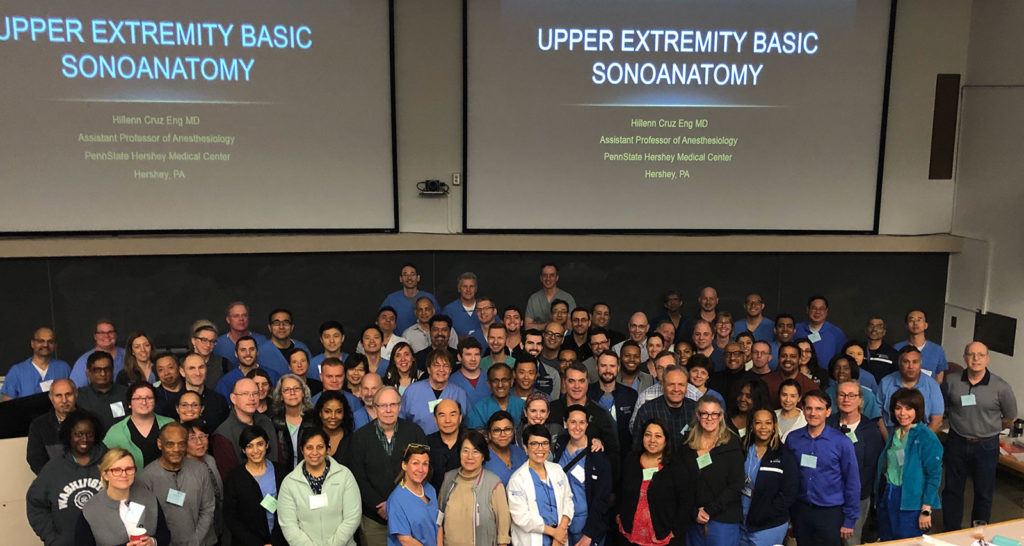Jump to topic
Search
Program Details
To be a candidate for the Regional Anesthesiology and Acute Pain Medicine Fellowship, the applicant must be completing (or already have completed) an ACGME-accredited anesthesiology residency. It is expected that the candidate be board-eligible for anesthesiology by the start of the training program.
The mission of the Regional Anesthesiology and Acute Pain Medicine Fellowship is to be patient and student advocates to ascertain excellence in education, patient safety and the alleviation of suffering from surgery and pain.
The program cultivates and sustains a collegial, respectful and nurturing environment of education and scholarship in anesthesia and pain medicine drawing from the expertise and knowledge of individuals from colleagues around the world.
The strategic focus is to conduct education, clinical care and research to enhance patient safety.
The program strives to recruit, retain and develop the very best trainees, faculty and personnel who share the vision of scholarship and patient care relevant to the worldwide anesthesia community.
Learn More about the Fellowship
The Regional Anesthesiology and Acute Pain Management Fellowship aims to:
- Train fellows to become consultant-level practitioners in regional anesthesiology and acute pain medicine capable of independent practice.
- Inspire excellence, innovation and dedication to the field of regional anesthesiology and acute pain medicine.
- Emphasize the institution’s core values of respect, integrity, teamwork and excellence.
- Inspire fellows to be lifelong learners.
- Develop the fellow’s leadership skills.
- Promote fellow involvement in the department’s wellness initiatives.
Application Overview
The program is still accepting applications for the 2025-2026 academic year. Please forward your complete application materials to our fellowship coordinator Rachel Sant at rsant@pennstatehealth.psu.edu.
Eligibility
Candidates must be:
- U.S. citizens, permanent residents or J-1 visa holder (no additional visa types are sponsored)
- Board-eligible or board-certified in anesthesiology
- Eligible for a Pennsylvania medical training license
Application Process
Applicants should complete and submit all necessary materials through the SF Match portal.
Interview Process
All interviews will be conducted remotely beginning in January 2024 as per Penn State Health policy. Applicants will receive further communication via email.
The Regional Anesthesia and Acute Pain Medicine (RAAPM) research component is involved with multiple clinical studies and quality improvement initiatives and is led by Dr. Sanjib Adhikary. A core focus for this team is orthopedic surgery, assessing both time-based cost analysis involving total joint arthroplasties as well as the efficacy of adductor canal catheters during physical rehabilitation post total knee replacement. Current initiatives also include Enhanced Recovery After Surgery protocols for breast surgery, traumatic rib fracture patients and the use of ketamine infusions for acute pain management. Other areas of interest consist of simulation-based training for resident and fellow education. The RAAPM team has contributed to multiple high-quality publications, textbook chapters and both internal and external grant applications. One of the team’s collective goals is to advance this specialty within the medical field.
Virtual Tour
Penn State Health
Penn State Health is a multi-hospital health system serving patients and communities across 29 counties of Pennsylvania. Its mission is to improve health through patient care, research, education and community outreach.
In December 2017, the system partnered with Highmark Health to facilitate creation of a value-based, community care network in the region. The shared goal of Highmark and Penn State Health is to ensure patients in the community are within:
- 10 minutes of a Penn State Health primary care provider
- 20 minutes of Penn State Health specialty care
- 30 minutes of a Penn State Health acute care facility
Learn more about Penn State Health

Penn State Health Children’s Hospital (left), Penn State Health Milton S. Hershey Medical Center (center) and Penn State Cancer Institute (right)
Penn State Health Milton S. Hershey Medical Center
500 University Dr., Hershey, Pa., 17033 (Derry Township, Dauphin County)
- The health system’s 647-bed flagship teaching and research hospital
- The only medical facility in Pennsylvania accredited as both an adult and a pediatric Level I (highest-level) trauma center
- Dedicated surgical, neuroscience, cardiovascular, trauma and medical intensive care units
- Accredited Life Lion critical-care transport providing more than 1,100 helicopter and approximately 750 ground ambulance transports per year
- More than 1,300 faculty members and more than 650 residents and fellows
- Approximately 29,000 admissions, 73,000 emergency department visits, 1.1 million outpatient visits and 33,000 surgical procedures annually
- Designated as a Magnet hospital since 2007
Learn more about Milton S. Hershey Medical Center
Penn State Health Children’s Hospital
600 University Dr., Hershey, Pa. 17033 (Derry Township, Dauphin County)
- An eight-story, 263,000-square-foot-facility built in 2013 and expanded in 2020
- 146 licensed pediatric beds, 18 acute care beds and a 56-bed neonatal intensive care unit
- Level IV (highest-level) neonatal intensive care unit
- Level I quaternary (highest-level) pediatric intensive care unit
- Level I (highest-level) pediatric trauma center designation
- Intermediate care unit
- Dedicated pediatric operating rooms
- More than 150,000 pediatric outpatient visits and approximately 5,000 pediatric patient discharges annually
Welcome to Hershey
More About Hershey
Interested in learning more about living and working in Hershey, Pa.? See details here:
Wellness, including emotional, spiritual, social and physical health, is a crucial component to training and to becoming a professional, compassionate and resilient physician. Self-care is a skill which must be continually practiced and reinforced. Penn State College of Medicine and Penn State Health are committed to addressing wellness among residents and fellows, with multiple resources readily available.
Institutional resources
- Visit BeWell – a health program designed to support Penn State Health employees
- See Penn State College of Medicine wellness resources here
- Employee Health Care Concierge and Case Management Service
- Partners in Medicine
Moving to a new city with your family does not have to be stressful. Residency programs have assisted many significant others with finding employment. There is also a GME-Wide Partners in Medicine (PIM) group that offers networking opportunities as well as various social and community oriented activities. - The Doctors Kienle Center for Humanistic Medicine
- Active and easily accessed Office of Professional Mental Health
Graduate medical education resources
Institutional Resources
Penn State Health and Penn State College of Medicine celebrate, embrace and support the diversity of all patients, faculty, staff, students and trainees.
Office for Diversity, Equity and Inclusion
In keeping with this, Penn State Health has an active Office for Diversity, Equity and Inclusion with various programs, networks and resource groups, including:
- Talks and lectures on diversity, equity and inclusion through the Inclusion Academy
- Regular events on topics such as eradicating racism and creating a culture of inclusiveness
- Many Business Employee Resource Groups (BERGs), including:
- Disability Business Employee Resource Group
- Interfaith Business Employee Resource Group
- LGBTQ+ Business Employee Resource Group
- Military and Veterans Business Employee Resource Group
- Multicultural Business Employee Resource Group
- NextGen Business Employee Resource Group
Learn more about the Penn State Health Office for Diversity, Equity and Inclusion
Learn more about the College of Medicine’s Office for Diversity, Equity and Belonging
Office for Culturally Responsive Health Care Education
The vision at Penn State College of Medicine and Penn State Health is to equip learners with the knowledge, skills and attitudes they will need to provide culturally excellent health care and research for an increasingly diverse U.S. population. The Office for Culturally Responsive Health Care Education was formed to help meet that goal.
Learn more about the Office for Culturally Responsive Health Care Education
Office for a Respectful Learning Environment
In addition, the institution does not tolerate discrimination, biases, microaggression, harassment or learner mistreatment of any kind, and any concerns are immediately addressed by the Office for a Respectful Learning Environment.
Learn more about the Office for a Respectful Learning Environment
Network of Under-represented Residents and Fellows
The Network of Under-represented Residents and Fellows (NURF) is a group of diverse residents and fellows representing all specialties. NURF’s goal is to promote cultural diversity in the residency programs through community involvement, mentorship with diverse faculty, professional networking and support for the recruitment of diverse medical students into the residency programs.
NURF is sponsored by the Penn State College of Medicine Graduate Medical Education Office and the Penn State Health Office for Diversity, Equity and Inclusion.
Curriculum Details
The fellow will be required to attend all scheduled lectures, simulation sessions and multidisciplinary conferences. More information is available by contacting program coordinator Rachel Sant at rsant@pennstatehealth.psu.edu.
- Acute pain management service
- Regional anesthesia
- Chronic pain management service
- Physical medicine & rehabilitation
- OR
- Physical therapy
- Hershey Outpatient Surgery Center
The fellow is required to attend the annual Ultrasound-Guided Cadaver Course for Regional Anesthesia and Point-of-Care Ultrasound held each May. The course is taught by Penn State faculty as well as other faculty from around the United States and Canada.
Objectives for this course include:
- Differentiate ultrasound images of vessels, peripheral nerves, tendons and nerve plexi and be able to discuss methods for improvement of ultrasound images to achieve the most benefit from the technique.
- Describe the benefits of using real-time, ultrasound guidance for regional anesthesia administration, including risk reduction strategies for nerve blocks.
- Demonstrate proficient and appropriate use of ultrasound scanning techniques in identifying specific targets, such as the needle, blood vessels, nerve structures or surrounding organs pertinent to peripheral nerve blocks.
- Develop hands-on nerve scanning skills on live volunteers, as well as hand-eye coordination and needling skills on phantoms, cadavers and anatomic models.
- Define the processes needed to prevent wrong-site nerve blocks and infection associated with single-shot and continuous nerve blocks and vascular catheters; and understand the etiology, prevention and treatment of nerve injury in patients with pre-existing neurologic disease.

Pictured are the faculty and participants in the Ninth Annual Ultrasound-Guided Cadaver Course for Regional Anesthesia and Point-of-Care Ultrasound held in May 2019.
Latest News from Anesthesiology






